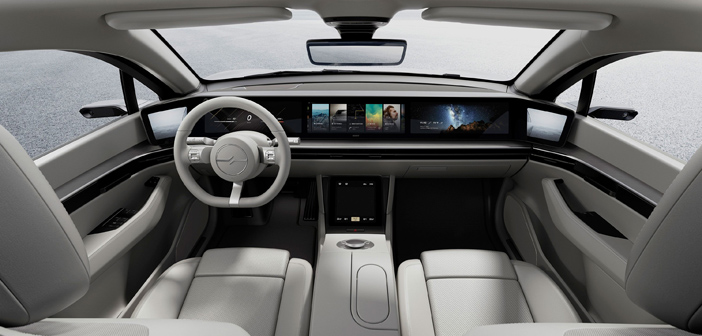Sony’s Vision-S, a prototype all-electric sedan, was one of the surprises of CES 2020. The AWD Vision-S is roughly the size of a Tesla Model S and built on a ‘skateboard’ chassis that could also underpin an SUV or MPV.
The Vision-S’s interior sports innovations aplenty. Sony says that, with the spread of 5G and the advancement of self-driving technology, people will eventually be relieved from car operations and the car cabin will evolve into a comfortable, living-room-like environment. Sony wants to create “a mobile entertainment space with a field of sound that encapsulates the entire body, a luxurious visual world of moving images, and intuitive user interfaces”.
With Sony’s 360 Reality Audio, object-based spatial audio technology is utilized “to recreate vivid realism that makes people feel like the artist is performing right before them”. Each musical element, such as vocals or instruments, can be placed in a spherical sound field based on the artist’s intended position. During playback, sound comes from 360° around the listener to recreate performances.
The realistic experience that 360 Reality Audio seeks to achieve will be based around the car’s seat speakers. The aim is to create a world in which each passenger can enjoy his or her favorite music in their seats with a personalized sound configuration.
Time-of-Flight (ToF) in-cabin sensing solutions use distance measurement technology to detect and recognize people and objects inside the car. The information is used to provide an optimized infotainment system with interfaces such as gesture control, and to improve safety and comfort inside the vehicle.
The Vision-S’s driver and passengers are presented with a row of displays that create a wide screen. An “intuitive” user interface “will enable each driver and passenger able to freely access content”, Sony claims. A jog dial will also be installed, allowing fingertip video control, even if the viewer has chosen to recline their seats.
Inside the cabin, sensors will monitor the condition of drivers and passengers. The facial expression and body movement of drivers will be used to gauge their concentration and fatigue levels, sending out alerts as necessary. The cabin temperature will be adjusted according to the condition and feelings of passengers. The safety of passengers will not be the only goal, Sony says: the aim is to also achieve a cabin environment that will be sensitive to people’s comfort.
Elsewhere, Sony believes that conventional automotive mirrors have advanced to a new level of performance through sensing and visual technology. Camera sensors will capture approaching vehicles and pedestrians and send an alert even before they can be detected by the human eye.
The three large displays in the cabin can be appropriately aligned according to the driver’s preference or urgency. For example, the room display (room mirror) in the center can show the view from both sides of the vehicle. If there is glare from the headlights of cars behind, HDR and other signal processing technology will enable the brightness to be adjusted. Sony says it will aim to leverage its array of sensing technologies to realize this next-generation safety system, providing smart mirrors that offer greater visibility and intelligence than conventional mirrors.
Sony has not announced whether the Vision-S will go into production, saying only that it is a prototype vehicle that showcases its efforts in the area of mobility.



